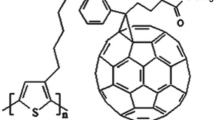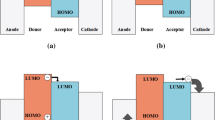Abstract
In this study, we designed a highly efficient ITO/PEDOT:PSS/P3HT:PCBM/Al-based bulk heterojunction organic solar cell. We investigated the performance of various optical and electrical properties of the designed organic solar cells. We improved the power conversion efficiency by using appropriate materials in different layers of the organic solar cells and refractive index and lattice constant matching among the layers. GPVDM simulator was used for simulating various properties of the organic solar cells, such as current density, voltage density, fill factor, and power conversion efficiency. Various parameters of the active layer of the organic solar cells were varied for optimization. In addition, we analyzed the impact of the thickness of the active layer and device series resistance on the improvement of the power conversion efficiency of the organic solar cells. Maximum power conversion efficiency of 16.46% with a fill factor of 74.09% was obtained for a series resistance of 15 ohms. We observed an inversely proportional relationship between power conversion efficiency and series resistance. We optimized the value of the thickness of the active layer as 75 nm while designing the organic solar cells to achieve maximum power conversion efficiency. We strongly believe that the proposed organic solar cell model will play a significant role in achieving high PCE organic solar cells.











Similar content being viewed by others
Data availability
The data supporting the findings of this study and its supplementary materials are available within the manuscript.
References
A. Toor, Renewables projected to overtake natural gas as world's second largest power source (2013), http://www.theverge.com/2013/6/28/44773694/. Accessed 25 Nov 2022
M. Lenes, Efficiency Enhancement of Polymer Fullerene Solar Cells. Ph.D thesis, (Zernike Institute, Univ. of Groningen, The Netherlands, 2009–13).
M. Pagliaro, G. Palmisano, R. Ciriminna, Flexible Solar Cells, Chap. 1, (Institute for Nanostructured Materials, Palermo, Italy, 2008), p. 3–4
G. Li, V. Shrotriya, J. Huang, Y. Yao, T. Moriarty, K. Emeryand, Y. Yang, High-efficiency solution processable polymer photovoltaic cells by self-organization of polymer blends. Nat. Mater. 4, 864–868 (2005)
C.J. Brabec, N.S. Sariciftci, J.C. Hummelen, Plastic solar cells. Adv. Func. Mater. 11, 15–26 (2011)
V.E. Ferry, J.N. Munday, H.A. Atwater, Design considerations for plasmonic photovoltaics. Adv. Mater. 22, 4794–4808 (2010)
J. Barker, C. Ramsdale, N. Greenham, Modeling the current-voltage characteristics of bilayer polymer photovoltaic devices. Phys. Rev. B 67, 1–9 (2003)
G. Buxton, N. Clarke, Predicting structure and property relations in polymeric photovoltaic devices. Phys. Rev. B 74, 1–5 (2006)
C.M. Martin, V.M. Burlakov, H.E. Assender, D.A.R. Barkhouse, A numerical model for explaining the role of the interface morphology in composite solar cells. Appl. Phys. 102, 104–506 (2007)
J. Williams, A.B. Walker, Two-dimensional simulations of bulk heterojunction solar cell characteristics. Nanotechnology 19, 424011 (2008)
M. Shah, V. Ganesan, Correlations between morphologies and photovoltaic properties of RodCoil block copolymers. Macromolecules 43, 543–552 (2010)
A. Abulimuand, D. Barbero, Measuring the Efficiency and Charge Carrier Mobility of Organic Solar Cells, (Depart. of Physics, Umeå Univ., Sweden, 2012)
Y. Yuan, T.J. Reece, P. Sharma, S. Poddar, S. Ducharme, Efficiency enhancement in organic solar cells with ferroelectric polymers. Nat. Mater. 10, 296–302 (2011)
P. Hudhomme, An overview of molecular acceptors for organic solar cells. Photovolt. 4, 40401 (2013)
J.-S. Yeo, J.-M. Yun, S.-S. Kim, D.-Y. Kim, J. Kim, S.-I. Na, Variations of cell performance in ITO-free organic solar cells with increasing cell areas. Semicond. Sci. Technol. 26, 034010 (2011)
P. Peumans, V. Bulovic, S.R. Forest, Efficient photon harvesting at high optical and electrical intensities in ultrathin organic double-heterostructure photovoltaic diodes. Appl. Phys. Lett. 76, 26–50 (2000)
M. Niggemann, M. Glatthaar, P. Lewer, C. Muller, J. Wagner, A. Gombert, Trapping light with micro lenses in thin film organic photovoltaic cells. Thin Solid Films 511, 628–633 (2006)
S. Rim, S. Zhao, S.R. Scully, M.D. McGehee, P. Peumans, An effective light trapping configuration for thin-film solar cells. Appl. Phys. Lett. 91, 501 (2007)
C.Y. Liu, Hybrid solar cells from polymers and silicon nanocrystals. ASME 3rd International conference on energy sustainability 1, 985–987 (2009)
H. Ade, New materials yield record efficiency polymer solar cells. (2014), http://www.konarka.com/index.php/site/. Accessed 25 Nov 2022
F.C. Krebs, Polymeric Solar Cells Materials Design Manufacture (DEStech Publications Inc., Lancaster, 2010)
Solid States Technology, Organic Electronics Workshop. (2011) http://www.electroiq.com/articles/sst/2011/. Accessed 25 Nov 2022
Lisa Zyga, Solar cell sets world record with a stabilized efficiency of 13.6%. http://phys.org/news/2015-06. Accessed 25 Nov 2022
Abu Kowsar et al., Comparative study on solar cell simulators. International Conference on innovation in engineering and technology (ICIET), (2019)
R.B. Kodati et al., A review of solar cell fundamentals and technologies. Adv. Sci. Lett. 26(5), 260–271 (2020)
R.B. Kodati et al., A survey of solar cell. Adv. Sci. Lett. 26(5), 1060–1065 (2020)
R. Rabeya et al. Design and performance analysis of multijunction organic solar cell exceeding 14% efficiency. 2018 10th International conference on electrical and computer engineering (ICECE), 321–324 (2018)
J. Singh et al., Optimizing the design of flexible PTB7:PC71BM bulk heterojunction and P3HT:SiNW hybrid organic solar cells. Nanosci. Technol. (2014). https://doi.org/10.15226/2374-8141/1/1/00103
Y. Ogata et al., Paper dye-sensitized solar cell based on carbon-nanotube-composite papers. Energies 13, 57 (2020)
P. Meredith et al., Scaling of next generation solution processed organic and perovskite solar cells. Nat. Commun. (2018). https://doi.org/10.1038/s41467-018-05514-9
R. Zhou et al., All-small-molecule organic solar cells with over 14% efficiency by optimizing hierarchical morphologies. Nat. Commun. (2019). https://doi.org/10.1038/s41467-019-13292-1
M. Farrokhifar, A. Rostami, N. Sadoogi, Opto-electrical simulation of organic solar cells. UKSim-AMSS 8th European modelling symposium, Pisa Pisa, Italy, (2014)
S. Oh, D. Yeo, K. Park, H. Kim, Performance enhancement of organic solar cells with the LiF/Al cathode structure by the pyromellitic dianhydride layer. Adv. Mater. Res. 415–417, 1608–1610 (2012)
N. Rastogi, N. Singh, Electrical simulation of organic solar cell at different series resistances and different temperatures. IOSR J. Appl. Phys. 8, 54–57 (2016)
M. Polyanskiy, Refractive index database. https://refractiveindex.info. Accessed 25 Nov 2022
Funding
No funding was received to assist with the preparation of this manuscript.
Author information
Authors and Affiliations
Corresponding authors
Ethics declarations
Conflict of interest
The authors have no conflicts of interest to disclose.
Additional information
Publisher's Note
Springer Nature remains neutral with regard to jurisdictional claims in published maps and institutional affiliations.
Rights and permissions
Springer Nature or its licensor (e.g. a society or other partner) holds exclusive rights to this article under a publishing agreement with the author(s) or other rightsholder(s); author self-archiving of the accepted manuscript version of this article is solely governed by the terms of such publishing agreement and applicable law.
About this article
Cite this article
Kundu, C.S., Adhikary, A., Ahsan, M.S. et al. Design and analysis of performance parameters for achieving high efficient ITO/PEDOT:PSS/P3HT:PCBM/Al organic solar cell. J Opt 53, 342–353 (2024). https://doi.org/10.1007/s12596-023-01230-w
Received:
Accepted:
Published:
Issue Date:
DOI: https://doi.org/10.1007/s12596-023-01230-w




